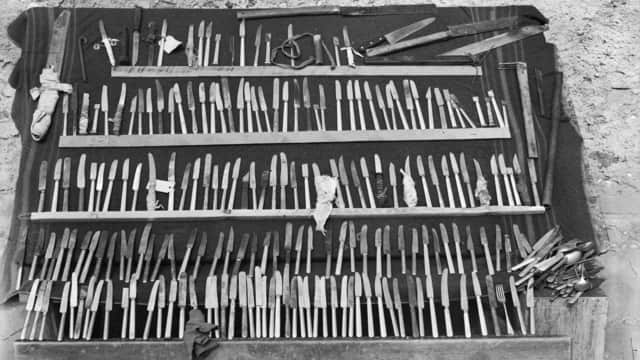The first time Teruo Murakami visited Cowra, in regional NSW, he was a 23-year-old Japanese prisoner of war.
Now 98, the former soldier has made the long journey back to the quiet town to mark the 75th anniversary of the date he and 358 other prisoners broke free, in what was the largest prison break of World War II, and in Australian history.
“I said yes to a riot because I wanted to die,” Mr Murakami told SBS News in Japanese on Monday.

Teruo Murakami, 98, is the last living survivor of the largest prison break of World War II. Source: SBS News
He explained it was never the plan to escape but to revolt.
“I’m sure most of my comrades did the same thing because we must not become POW.”
More than 1,100 Japanese prisoners of war voted to riot, and in the days that followed, 231 of his comrades and four Australians lost their lives.
“At first I broke out to die because I made the decision I wasn’t afraid,” he said.
“But later I changed my mind.”
Cutting through the wire fences with baseball bats and kitchen knives, hundreds of prisoners spilt into the small Australian town. Many, including Mr Murakami, were forced to shelter from bullets in a ditch overnight.
“An Australian came and spoke in Japanese saying, ‘we will not harm you but you have to come back. Get out of the ditch’,” he said.
When dawn came, Mr Murakami and his comrades surrendered.
How the breakout happened
During the 1940s, Cowra was home to many military facilities, including a training camp, munitions factory and a prison. Spread over 30 hectares, the camp was home to more than 4,000 prisoners of war from Japan, Germany, Italy, Indonesia and Korea.
In the weeks leading up to the breakout, the Japanese compound in the camp had become overcrowded. In an effort to reduce the strain, authorities decided to move 700 prisoners to a nearby camp in Hay.
“Now that announcement was made quite quickly, it was done to the three Japanese leaders of that particular compound and they objected to that,” Graham Apthorpe, the author of two books on the breakout, told SBS News.
“It became a trigger to riot and to break out.”
The Japanese prisoners were split into five groups of 20 to 30 people and each of the group leaders handed those in their charge a blank piece of paper. The prisoners were instructed to mark it with a cross or a circle - a cross indicated they did not want to riot, a circle showed they did.

Mr Murakami had a clear message for future generations: "No war. Never, never again". Source: SBS News
Overwhelmingly, the prisoners voted to revolt.
“We had to draw a circle or cross. A cross means no. I drew a circle,” Mr Murakami said.
On 5 August 1944, the camp’s Japanese prisoners - who held a particular shame about having been captured instead of suiciding - put their plan into action.
“It was a very cold season just like now,” Mr Murakami said.
“And we had a big fire and put blankets in to make it big. We wanted to burn everything.”
At approximately 2am, a Japanese soldier ran screaming towards the prison gates. Then a bugle sounded and the other prisoners moved swiftly into action, attacking the wire fencing with their homemade weapons.
Two Australian soldiers turned machine guns on the escaping prisoners but it was too late - they were outnumbered by the prisoners, and beat and stabbed to death.

Improvised weapons found in and around B compound of the Cowra Prisoner of War camp immediately after the mass escape. Source: Australian War Memorial/4217079
Running from the compound, Mr Murakami said there were “so many bullets” flying over his head. While hiding in the ditch, a flare shot through the sky and it was “as light as day”.
“Hours passed while I was hiding in the ditch,” he said.
The final journey
The breakout's 75th anniversary will likely be the final time Mr Murakami visits Cowra, but younger generations are eager to continue honouring the Japanese people who died in Australia during the war.

Kaori Irobe traveled to Cowra to view her grandfather's grave. Source: SBS News
Kaori Irobe's grandfather relocated from Japan to Australia. The 33-year-old said she “was speechless” after viewing her grandfather’s final resting place for the first time this week.
“I thought that I can finally see him directly,” she said.
Ms Irobe’s grandfather, Yasukichi Murakami died while he was interned during WWII and was buried at Cowra’s Japanese cemetery alongside the 231 Japanese soldiers killed during the breakout.
During the war, all Japanese civilians in Australia were detained as foreign enemies.
Travelling to NSW for the first time, Ms Irobe said it was important for her to come here and “trace her family history”.
“I think I will keep researching about my family and will definitely keep a connection with Australia,” she said.

Ms Irobe pays her respects to her grandfather, who died in Australia during World War II. Source: SBS News
As he prepares to pass his tradition on to the younger generation, Mr Murakami had a very clear message.
“I don’t want any young person to do the things we have done, because it’s such a miserable thing,” he said.
“No to war. Never, never again.”

